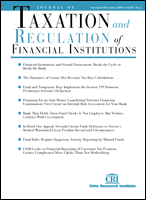Complete Issue
Author: Houman Shadab.
Source: Volume 26, Number 04, March/April 2013 , pp.1-56(56)

< previous article |return to table of contents
Abstract:
As the U.S. economy seems to be entering a period of real—if tepid—recovery, banks and other financial institutions will increasingly find themselves faced with legal and tax issues that reflect increased economic activity. This issue of the Journal of Taxation and Regulation of Financial Institutions provides in-depth analysis of several such issues. Our first article, by Michael B. Staebler, provides a comprehensive examination of the Small Business Investment Company (SBIC) program. SBICs are privately owned and operated investment companies licensed by the United States Small Business Administration (SBA). Investment companies are eligible to receive up $150 million in debt financing from the SBA. In addition, changes made by the Dodd-Frank Act of 2010 make it easier for banks to invest in SBICs. Mr. Staebler’s article covers several fundamental issues regarding SBICs, including what legal and financial considerations should factor into the decision to form a SBIC, formation and structure, the mechanics of getting licensed, SBA-provided leverage, investment distributions, structures, eligibility, and regulatory considerations. Despite reports of banks’ increasing willingness to make commercial loans, SBICs may offer an overlooked source of much-needed financing for small business. Economic recovery may also see more capital flowing to fund historic rehabilitation projects. In our second article, Penny S. Indictor analyzes the often complex rules and transaction structures surrounding the Historic Tax Credit (HTC), which provides a 20 percent tax credit for rehabilitating certain “certified historic structures” and a 10 percent tax credit for rehabilitating nonresidential buildings created prior to 1936. Ms. Indictor discusses the Single Tier and Lease Pass-Through HTC structures, as well as structuring the equity portion of the transaction and the importance of the 2011 ruling in Historic Boardwalk Hall, which denied applicability of the tax credit to an equity investor. Ms. Indictor also examines the way in which the HTC may be combined with other tax credits such as the Low-Income Housing Tax Credit, the New Markets Tax Credit, and state historic tax credits. A potential return to steady economic growth in the U.S. may also see an increase in remittance transfers outside of the country. In our third article, Nicholas W. Turner reviews the development and regulation of remittance transfers. The newly created Consumer Financial Protect Bureau (CFPB) is required by the Dodd-Frank Act to regulate the U.S. market for remittances. Mr. Turner details the proposed rules relating to disclosures required by banks and other remittance providers, the mostly critical comments received in reaction to the proposals, and the CFPB’s final rules issued in February and August of 2012. This issue ends with a column by Ira Bogner. Mr. Bogner discusses the October 18, 2012, Sun Capital decision handed down by the U.S. District Court for the District of Massachusetts, in which the court declined to find two private equity firms liable for the underfunded pension liability of one of their portfolio companies.Keywords: Start-Up America, IRC Sec. 47, Dodd-Frank Act Sec. 1073, Consumer Financial Protection Bureau, unfunded pension plan liabilities
Affiliations:
1: New York Law School.